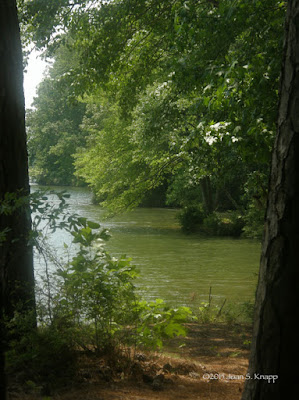The route… I’ve described it here, here, here, and here This walk doesn’t have the variety of wildflowers as my other
walk from the Group A Shelter to the Old Fort but it does have some gems. One
of the Smallflower (Asimina parviflora) had developed fruit and some
Green Adder’s-mouth (Malaxis unifolia) Orchids were blooming.
A grass - it may be Orchard Grass (Dactylis glomerata) was starting to bloom, both in the
open and in the woods.
The woods were shaded and quite dark on a cloudy day.
Most of the Rattlesnake Ferns (Botrychium virginianum)
in the ‘Christmas Fern Grove’ had released their spores.
This fern was about ready to release its spores.
Orange-patched Smoky (Pyromorpha dimidiata) moths were still in the woods.
I was still curious about how the Witch’s Butter (Tremella
mesenterica) would age. It was still easy to find on the branch that fell
during the heavy wind storms early in the year. It appeared unchanged from the
previous week.
I found another two old Blackberry Knot galls, probably from
last year. This makes three old galls that I’ve found this year. However, I
haven’t seen one from this season. (I had found one near our mailbox last year;
this is what they look like when young.)
Looking across the lake from the trail.
The buds on Pipsissewa (Chimaphila maculata) were swelling
slightly.
Then on up ‘The Hill’ to see if the…
fruit was still on the Smallflower Pawpaw (Asimina
pariviflora) plant at the top. It had swelled noticaebly from the previous week.
The petals had fallen off most of the Tulip Poplar
(Liriodendron tulipifera) flowers although they remained on one. It would be interesting to watch seed development next.
Harvestman spiders have been plentiful this spring.
And on through the young pine woods to the Outer Trail that
took me down to the dam.
(To be continued…)
Related
posts:












































































